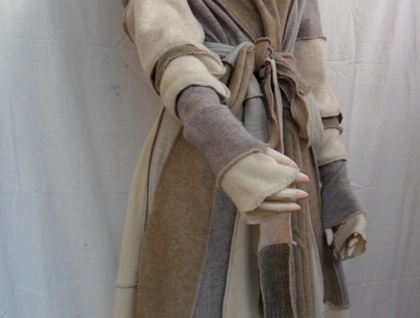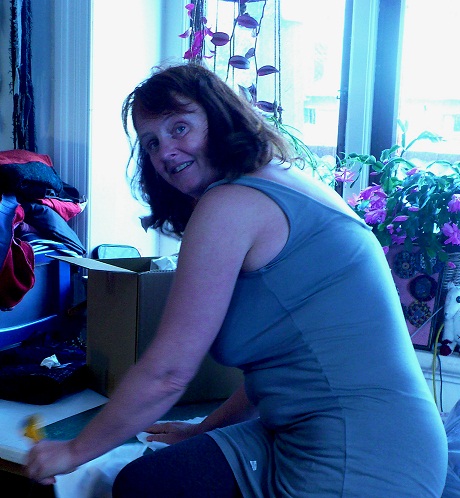Christchurch: From rags to rethreads

Local Good News/Christchurch
By Steve Carter
Briar Cook is making me a skirt.
Leaving aside for now the reasons why that might be, I’m assured that it will be “kiltish and kick-ass.” That suits me just fine. Besides, it’s not just any old skirt co-opted by a man with a taste for the unconventional. I am reminded of the old joke format: Q: When is a skirt not a skirt? A: When it’s pieces of an old evening jacket and a bunch of scavenged ties.
Briar is the creative mind behind independent clothing label rethreads, a “big fat NO to the fashion industry with all the inherent waste and inequalities that are built in.” This is one-off, upcycled clothing with an edge. You might call it Guerilla Clothing … after all, Briar does.
Briar started making funky and unique clothing for herself when she was sixteen, long before the word ‘upcycle’ had even been coined. Her motivation came from her
environment, a punk-infused Vancouver alternative scene with its desire to stick two fingers up to the establishment. Indeed, she has recently been conceiving of what it
is that makes up the philosophy of rethreads and those fingers are still cocked … at the mainstream, at the fashion industry and at our wasteful economic system.
Not that she’s an angry activist. She speaks passionately about the problems our society is creating for itself and her desire to be part of the solutions, but she also qualifies her words with a healthy cynicism about the often glib ‘Save The Planet’ mantra. Hers is a practical approach to real world economy. As she says, “I’ve always just been interested in using what’s around.”
A perfect example might be her aim to create a zero waste nirvana for the studio. It’s not simply an ideological conceit, but an approach grounded in common sense. What
one person might call waste, another might see as a treasure trove of possibility. Many other businesses benefit from her leftovers, just as she benefits from re-tailoring cast-off clothing.
She shows me a month’s worth of studio ‘rubbish’ in a tiny waste basket and it seems clear that she is well on the way to achieving a beautifully closed loop.
If the iniquities of the fashion industry come in for a verbal bashing, that’s not to say that her clothing is in any way subordinate in standard. It is eye-catching and quirky (and I assert this while modelling her signature piece, a magnificent full-length coat made entirely from stuffed toys) but it is also primarily wearable and practical.
Sure, there is an appeal to alt.culture in many of the rethreads items, but Briar is just as keen to engage in dialogue with Middle New Zealand about its engagement with clothing and design. Not everything is calculated to raise a smile or an eyebrow – her work is infused with quality of craft, and much of it screams accessibility. If, along the way, it will also inspire people to think about their resistance to secondhand clothing, or about the restrictions imposed upon them by high street labels and cultural norms, or even about notions of what is ‘acceptable’ or ‘different’, then Briar will be a happy woman. It’s a spirit of activism and challenge, tempered by the reality of people’s daily living circumstances and the attitudes that underpin them.
Briar puts it smartly into context.
“We have systems that don’t work and which create human/environmental misery … and the fashion industry is one,” she says, “so we need ‘tearer-downers’, the sort of people who will front up to wrongs, protest, or even be prepared to go to jail for their political beliefs.”
She would love to be one of those people, but she also admits that she has never really had the nervous disposition for that form of sustained action. Instead, she is the other type of activist: “a builder-upper,” the one who, once the doors are kicked open, will work to create solutions, and suggest alternatives and new ways of thinking. Both approaches are valid and they work in tandem to forge a forward momentum for change.
As Briar says herself, “I’ve kind of fallen into sustainability, and I’m happy to represent it … but that’s why I don’t want to turn my back on Middle New Zealand. Most people are attracted to the work because it is good work, because it looks “cool”. Some will get that it is recycled straight away, but many don’t.”
 When they find out the nature of the work, she observes one of two responses: “Some people say “wow, that makes it even cooler!” but for others, you can see a sort of mental adjustment going on that allows them to make it okay.”
When they find out the nature of the work, she observes one of two responses: “Some people say “wow, that makes it even cooler!” but for others, you can see a sort of mental adjustment going on that allows them to make it okay.”
At a time where there is an increasing acknowledgment of a need to manage our systems differently, there’s also a kind of stasis in people who don’t quite know where to
start making changes in their own lives. An old write-up for rethreads captures Briar’s philosophy beautifully: “When you buy a rethreads garment you get to adopt a whole set of values that feel fantastic to live by! Your contribution to a world that is fit for our children and grandchildren to live in is only a few dollars away.”
If you also get to turn heads by wearing something well-made and totally unique, then that has to be even better.
I should know. I will soon have a crash-hot skirt in my wardrobe.
Find out more about rethreads at http://www.facebook.com/rethreadsnz or at http://felt.co.nz/shop/rethreads
Read the inspiring stories of our Christchurch sponsors:
 SHAC – The Sustainable Habitat Challenge – is a network of architects, builders, engineers, designers, building scientists, students and young professionals interested in taking positive action in their communities today.
SHAC – The Sustainable Habitat Challenge – is a network of architects, builders, engineers, designers, building scientists, students and young professionals interested in taking positive action in their communities today.
On the 2-3 May 2012, SHAC presented the 2nd annual workshop on micro-architecture at the Christchurch Polytechnic Student Centre. Sixty attendees discussed temporary architecture, simple buildings, and the reuse of building material.
“People cherish their culture through recycling” – those are the words of Wang Shu, the 2012 winner of the Pritzker architecture prize. The demolition of red stickered housing and CBD buildings does not have to mean the eradication of Christchurch’s history or culture – nearly all materials can be reused in new construction, incorporating local memories and fusing the past with the present.
What is permanent in this land of earthquakes? In San Francisco, the Palace of Fine Arts was built in 1915 as a temporary building for the Panama-Pacific Exposition and still stands today as an icon of the city. From the cardboard cathedral to the convention centre – how long will they serve us?
“Simple buildings are key for affordability” said Canadian architect Brian McKay Lyons, recently interviewed on Nine to Noon with Kim Hill. Lyons, from Nova Scotia, says “simple buildings are what we farmers and fishermen build when we can’t afford to get things wrong”
This symposium brought together elements of the growing Regeneration movement – people working together to take positive action in their communities.
Community Rebuild – for the Whole House Reuse project Juliet Arnott
Community Development – Joshua Durrant, Jess Smale, Sophie Moore
Positive Action – Gapfiller Trust
 YTONG® is an alternative building system made from light-weight Aerated Autoclaved Concrete (AAC). It was invented in Sweden in 1923 and further developed under the YTONG® brand it turned into a world-wide success.
YTONG® is an alternative building system made from light-weight Aerated Autoclaved Concrete (AAC). It was invented in Sweden in 1923 and further developed under the YTONG® brand it turned into a world-wide success.
Environmentally friendly and non-toxic – From the manufacturing process to shipment, construction, and waste disposal YTONG® is in ecological balance.
Good sound absorption – effective sound barrier – The natural air cushion formed in the high-pressure steam curing of AAC can absorb the most possible noise.
Ensures high standard of well-being – YTONG® reduces temperature differences and humidity fluctuations and so ensures a comfortable and healthy room atmosphere.
Excellent workability – It is easy to erect a solid masonry structure quickly and precisely. Only few tools and implements are necessary.
Outstanding thermal insulation – Keeps buildings cool in summer and warm in winter saving on heating and air-conditioning.
YTONG® is fireproof and has a high fire rating – AAC is resistant to high temperatures for a longer period of time than any other solid building material. YTONG® is especially chosen for fireproof walls in commercial buildings.
Performs well in earthquakes – Thanks to its low weight and its plastic deformation properties the destructive force of earthquakes can be minimised.
 Social Innovation is a small, hardworking community engagement agency based in Christchurch. They work with leading non-profits, changemakers, progressive companies and government to mobilise everyday New Zealanders. Their expertise in this area comes from grassroots innovation on large-scale community action projects, including the Student Volunteer Army, A Day at the Beach Festival, Love your Coast and a number of other public participation initiatives. They know how to scale initiatives and achieve big results with large numbers of stakeholders.
Social Innovation is a small, hardworking community engagement agency based in Christchurch. They work with leading non-profits, changemakers, progressive companies and government to mobilise everyday New Zealanders. Their expertise in this area comes from grassroots innovation on large-scale community action projects, including the Student Volunteer Army, A Day at the Beach Festival, Love your Coast and a number of other public participation initiatives. They know how to scale initiatives and achieve big results with large numbers of stakeholders.
 kiwi folk heroes like Kate Sheppard combined with the sheer power of modern technology. At the heart of what they do is supporting everyday New Zealanders to take action and participate fully in public life, in turn increasing the proportion of citizen’s who know that they can make a difference to the way things are.
kiwi folk heroes like Kate Sheppard combined with the sheer power of modern technology. At the heart of what they do is supporting everyday New Zealanders to take action and participate fully in public life, in turn increasing the proportion of citizen’s who know that they can make a difference to the way things are.Their services include strategy, leadership training, volunteer coordination & management, media and communications, project management and fundraising. Find out more at www.socialinnovation.org.nz or make direct contact via their studio-line on 03 337 0861
Ph: 03 337 0861 or [email protected]
loading...
loading...



[...] Happyzine – June 2012 [...]